The Anatomy of a Foot Stress Fracture
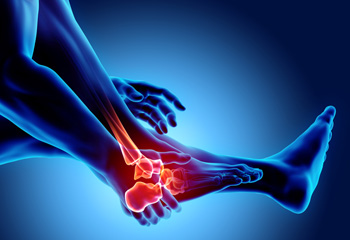
A foot stress fracture is a common injury resulting from repetitive strain and overuse of the bones in the foot. Unlike acute fractures caused by sudden trauma, stress fractures develop gradually due to the cumulative effect of repetitive stress on the bones, often stemming from activities like running, jumping, or prolonged standing. These microcracks typically occur in weight-bearing bones, such as the metatarsals, and can lead to localized pain, swelling, and tenderness. Foot stress fractures are particularly prevalent among athletes and individuals engaged in high-impact activities. Recognizing the symptoms, which may mimic other foot conditions, is essential for an accurate diagnosis and timely intervention. Rest, along with wearing proper footwear and a gradual return to activity, forms the cornerstone of treatment. If you have endured a foot stress fracture, it is suggested that you consult a podiatrist who can confirm the diagnosis and offer the treatment method that is best for you.
Stress fractures occur when there is a tiny crack within a bone. To learn more, contact Donald Manger, DPM from Associated Podiatric Physicians, PA. Our doctor can provide the care you need to keep you pain free and on your feet.
How Are They Caused?
Stress fractures are the result of repetitive force being placed on the bone. Since the lower leg and feet often carry most of the body’s weight, stress fractures are likely to occur in these areas. If you rush into a new exercise, you are more likely to develop a stress fracture since you are starting too much, too soon. Pain resulting from stress fractures may go unnoticed at first, however it may start to worsen over time.
Risk Factors
- Gender – They are more commonly found in women compared to men.
- Foot Problems – People with unusual arches in their feet are more likely to develop stress fractures.
- Certain Sports – Dancers, gymnasts, tennis players, runners, and basketball players are more likely to develop stress fractures.
- Lack of Nutrients – A lack of vitamin D and calcium may weaken the bones and make you more prone to stress fractures
- Weak Bones – Osteoporosis can weaken the bones therefore resulting in stress fractures
Stress fractures do not always heal properly, so it is important that you seek help from a podiatrist if you suspect you may have one. Ignoring your stress fracture may cause it to worsen, and you may develop chronic pain as well as additional fractures.
If you have any questions, please feel free to contact our office located in Hamilton Township, NJ . We offer the newest diagnostic and treatment technologies for all your foot care needs.
The Link Between Increased Body Mass and Foot Discomfort

Exploring the correlation between elevated body mass and foot pain unveils a compelling relationship. Excess weight places additional stress on the feet, leading to discomfort and various conditions. The arches, heels, and joints bear the brunt of this burden, potentially resulting in ailments such as plantar fasciitis and osteoarthritis. The arch of the foot may collapse under the strain, causing pain and instability. Additionally, increased body mass may contribute to the degradation of joints, accelerating wear and tear. Overpronation, an inward rolling motion of the foot, becomes more prevalent, exacerbating discomfort. Recognizing this connection is pivotal for those grappling with foot pain, as shedding excess weight through a balanced diet and exercise regimen can significantly alleviate symptoms. If you are overweight and have foot pain, it is suggested that you confer with a podiatrist for treatment..
Obesity has become very problematic at this point in time and can have extremely negative effects on the feet. If you’re an obese individual and are concerned about your feet, contact Donald Manger, DPM from Associated Podiatric Physicians, PA. Our doctor can provide the care you need to keep you pain-free and on your feet.
Obesity and Your Feet
Since your feet are what support your entire weight when standing, any additional weight can result in pain and swelling. Being overweight is one of the main contributors to foot complications.
Problems & Complications
Extra Weight – Even putting on just a few extra pounds could create serious complications for your feet. As your weight increases, your balance and body will shift, creating new stresses on your feet. This uneven weight distribution can cause pain, even while doing the simplest tasks, such as walking.
Diabetes – People who are overweight are at serious risk of developing type-2 diabetes, which has a drastic impact on the health of your feet. As you get older, your diabetes might worsen, which could lead to loss of feeling in your feet, sores, and bruises. You could also become more prone to various infections.
Plantar fasciitis – Pressure and stress that is placed on muscles, joints, and tendons can trigger plantar fasciitis, which is an inflammation of tissue that forms along the bottom of the foot.
If you have any questions please feel free to contact our office located in Hamilton Township, NJ . We offer the newest diagnostic and treatment technologies for all your foot and ankle needs.
Causes and Diagnostic Avenues for Gout
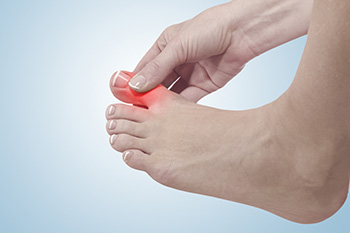
Gout, a form of arthritis, develops when uric acid accumulates in the joints, leading to inflammation and intense pain. The primary cause is an overproduction or underexcretion of uric acid, resulting in crystalline deposits that settle in the joints. Dietary factors, such as excessive consumption of purine-rich foods, can contribute to elevated uric acid levels. Diagnosis involves a comprehensive examination of symptoms that include sudden, severe joint pain, swelling, and redness. Podiatrists may conduct blood tests to measure uric acid levels and analyze joint fluid for crystal presence. Imaging studies, such as X-rays or ultrasounds, aid in assessing joint damage. A meticulous evaluation helps differentiate gout from other forms of arthritis, enabling podiatrists to devise an effective treatment plan. If you have joint pain in your feet and believe it might be caused by gout, it is suggested that you are under the care of a podiatrist who can successfully treat this condition and offer preventive tips.
Gout is a painful condition that can be treated. If you are seeking treatment, contact Donald Manger, DPM from Associated Podiatric Physicians, PA. Our doctor will treat your foot and ankle needs.
What Is Gout?
Gout is a form of arthritis that is characterized by sudden, severe attacks of pain, redness, and tenderness in the joints. The condition usually affects the joint at the base of the big toe. A gout attack can occur at any random time, such as the middle of the night while you are asleep.
Symptoms
- Intense Joint Pain - Usually around the large joint of your big toe, and it most severe within the first four to twelve hours
- Lingering Discomfort - Joint discomfort may last from a few days to a few weeks
- Inflammation and Redness -Affected joints may become swollen, tender, warm and red
- Limited Range of Motion - May experience a decrease in joint mobility
Risk Factors
- Genetics - If family members have gout, you’re more likely to have it
- Medications - Diuretic medications can raise uric acid levels
- Gender/Age - Gout is more common in men until the age of 60. It is believed that estrogen protects women until that point
- Diet - Eating red meat and shellfish increases your risk
- Alcohol - Having more than two alcoholic drinks per day increases your risk
- Obesity - Obese people are at a higher risk for gout
Prior to visiting your podiatrist to receive treatment for gout, there are a few things you should do beforehand. If you have gout you should write down your symptoms--including when they started and how often you experience them, important medical information you may have, and any questions you may have. Writing down these three things will help your podiatrist in assessing your specific situation so that he or she may provide the best route of treatment for you.
If you have any questions, please feel free to contact our office located in Hamilton Township, NJ . We offer the newest diagnostic and treatment technologies for all your foot care needs.
Treatment Options for Achilles Tendon Pain

Injuries to the Achilles tendon, which connects the calf muscle to the heel bone, commonly lead to Achilles tendonitis or Achilles tendonosis. Both cause pain, stiffness, and discomfort in the lower leg. Differentiating between the two is necessary for effective treatment. Achilles tendonitis results from overuse or sudden activity increase. If left untreated, it may progress to Achilles tendonosis, where the inflamed tendon degenerates, develops microscopic tears, and possibly ruptures. Treatment options vary based on severity, including immobilization with casts, walking boots, or night splints. Recovery typically takes two to three months, but if nonsurgical approaches fail, surgical options like gastrocnemius recession, debridement, and repair, or debridement with tendon transfer may be considered. Surgical intervention is a last resort, emphasizing the importance of early diagnosis and tailored treatment by a podiatrist to prevent further progression of Achilles tendon conditions. For an exam and treatment options, it is suggested that you schedule an appointment with a podiatrist who can discuss the treatment method that is best for you.
Achilles tendon injuries need immediate attention to avoid future complications. If you have any concerns, contact Donald Manger, DPM of Associated Podiatric Physicians, PA. Our doctor can provide the care you need to keep you pain-free and on your feet.
What Is the Achilles Tendon?
The Achilles tendon is a tendon that connects the lower leg muscles and calf to the heel of the foot. It is the strongest tendon in the human body and is essential for making movement possible. Because this tendon is such an integral part of the body, any injuries to it can create immense difficulties and should immediately be presented to a doctor.
What Are the Symptoms of an Achilles Tendon Injury?
There are various types of injuries that can affect the Achilles tendon. The two most common injuries are Achilles tendinitis and ruptures of the tendon.
Achilles Tendinitis Symptoms
- Inflammation
- Dull to severe pain
- Increased blood flow to the tendon
- Thickening of the tendon
Rupture Symptoms
- Extreme pain and swelling in the foot
- Total immobility
Treatment and Prevention
Achilles tendon injuries are diagnosed by a thorough physical evaluation, which can include an MRI. Treatment involves rest, physical therapy, and in some cases, surgery. However, various preventative measures can be taken to avoid these injuries, such as:
- Thorough stretching of the tendon before and after exercise
- Strengthening exercises like calf raises, squats, leg curls, leg extensions, leg raises, lunges, and leg presses
If you have any questions please feel free to contact our office located in Hamilton Township, NJ . We offer the newest diagnostic tools and technology to treat your foot and ankle needs.
Strengthening Exercises for Improved Arch Support
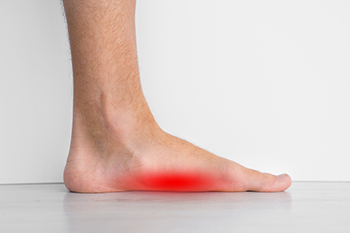
Flat feet, or pes planus, can benefit from targeted exercises that aim to strengthen the muscles surrounding the arches. Toe curls, a simple yet effective exercise, involve gripping a towel with your toes and lifting it off the ground. This helps engage the muscles along the arch and promotes better support. Arch lifts, where you lift the inner edge of your foot while keeping the outer edge on the ground, target the muscles responsible for maintaining the foot's arch structure. Heel cord stretches alleviate tension in the Achilles tendon and calf muscles, supporting overall foot flexibility. Additionally, ankle circles, rotating your ankles in both directions, enhance mobility and contribute to improved arch function. Incorporating these exercises into your routine gradually can contribute to the development of stronger foot muscles, providing better arch support and potentially aiding in the correction of flat feet over time. Consistency is key as you work toward building strength and stability in the intricate network of muscles that shape the foundation of your feet. If you have flat feet, it is suggested that you confer with a podiatrist who can offer you effective stretches and other relief techniques.
Flatfoot is a condition many people suffer from. If you have flat feet, contact Donald Manger, DPM from Associated Podiatric Physicians, PA. Our doctor will treat your foot and ankle needs.
What Are Flat Feet?
Flatfoot is a condition in which the arch of the foot is depressed and the sole of the foot is almost completely in contact with the ground. About 20-30% of the population generally has flat feet because their arches never formed during growth.
Conditions & Problems:
Having flat feet makes it difficult to run or walk because of the stress placed on the ankles.
Alignment – The general alignment of your legs can be disrupted, because the ankles move inward which can cause major discomfort.
Knees – If you have complications with your knees, flat feet can be a contributor to arthritis in that area.
Symptoms
- Pain around the heel or arch area
- Trouble standing on the tip toe
- Swelling around the inside of the ankle
- Flat look to one or both feet
- Having your shoes feel uneven when worn
Treatment
If you are experiencing pain and stress on the foot you may weaken the posterior tibial tendon, which runs around the inside of the ankle.
If you have any questions please feel free to contact our office located in Hamilton Township, NJ . We offer the newest diagnostic and treatment technologies for all your foot and ankle needs.
Strategies to Prevent Falls in Every Room at Home
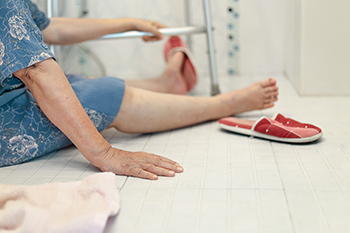
Creating a safe environment within each room of your house is vital to preventing falls and promoting overall well-being. In the bathroom, install non-slip mats and grab bars near the shower and toilet to enhance stability. Keep pathways clear in the living room, securing loose rugs and removing clutter that might pose a tripping hazard. Adequate lighting in the bedroom is essential for visibility, reducing the risk of stumbling in the dark. In the kitchen, ensure spills are promptly cleaned, and arrange commonly used items within easy reach to avoid unnecessary stretching or bending. Staircases demand sturdy handrails and proper lighting to facilitate safe navigation. Regularly inspect and maintain flooring in all rooms, addressing any uneven surfaces promptly. By incorporating these preventive measures throughout your home, you create a secure living space that minimizes the likelihood of falls, allowing you to move confidently and enjoy every room without the worry of potential accidents. If you require additional information about implementing fall prevention techniques which may help to protect the feet, it is suggested that you speak with a podiatrist.
Preventing falls among the elderly is very important. If you are older and have fallen or fear that you are prone to falling, consult with Donald Manger, DPM from Associated Podiatric Physicians, PA. Our doctor will assess your condition and provide you with quality advice and care.
Every 11 seconds, an elderly American is being treated in an emergency room for a fall related injury. Falls are the leading cause of head and hip injuries for those 65 and older. Due to decreases in strength, balance, senses, and lack of awareness, elderly persons are very susceptible to falling. Thankfully, there are a number of things older persons can do to prevent falls.
How to Prevent Falls
Some effective methods that older persons can do to prevent falls include:
- Enrolling in strength and balance exercise program to increase balance and strength
- Periodically having your sight and hearing checked
- Discuss any medications you have with a doctor to see if it increases the risk of falling
- Clearing the house of falling hazards and installing devices like grab bars and railings
- Utilizing a walker or cane
- Wearing shoes that provide good support and cushioning
- Talking to family members about falling and increasing awareness
Falling can be a traumatic and embarrassing experience for elderly persons; this can make them less willing to leave the house, and less willing to talk to someone about their fears of falling. Doing such things, however, will increase the likelihood of tripping or losing one’s balance. Knowing the causes of falling and how to prevent them is the best way to mitigate the risk of serious injury.
If you have any questions, please feel free to contact our office located in Hamilton Township, NJ . We offer the newest diagnostic and treatment technologies for all your foot care needs.
The Benefits of Foot Exercises
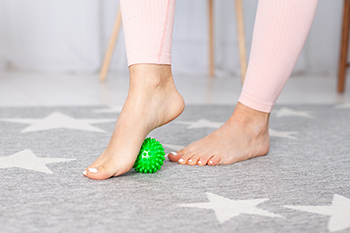
Foot exercises are an often underestimated yet invaluable practice for maintaining overall well-being. Your feet, the foundation of your body, carry the weight of your daily life. Engaging in regular foot exercises brings numerous benefits, including improved balance, enhanced flexibility, and reduced risk of common foot problems. Stretching and strengthening exercises can alleviate foot pain and discomfort, making them particularly useful for those with conditions such as plantar fasciitis or bunions. Foot exercises may also help to enhance blood circulation, which can have a positive impact on your overall cardiovascular health. Moreover, as your feet and lower limbs become stronger, you will experience better posture and alignment, reducing strain on your joints and spine. Embracing these exercises as part of your routine can lead to healthier, happier feet, allowing you to move through life with comfort and confidence. Exercising the feet can bring stability to the body. If you are interested in learning more about specific foot exercises to perform, it is suggested that you confer with a podiatrist.
Exercising your feet regularly with the proper foot wear is a great way to prevent injuries and build strength. If you have any concerns about your feet, contact Donald Manger, DPM from Associated Podiatric Physicians, PA. Our doctor can provide the care you need to keep you pain-free and on your feet.
Exercise for Your Feet
Exercise for your feet can help you gain strength, mobility and flexibility in your feet. They say that strengthening your feet can be just as rewarding as strengthening another part of the body. Your feet are very important, and we often forget about them in our daily tasks. But it is because of our feet that are we able to get going and do what we need to. For those of us fortunate enough to not have any foot problems, it is an important gesture to take care of them to ensure good health in the long run.
Some foot health exercises can include ankle pumps, tip-toeing, toe rises, lifting off the floor doing reps and sets, and flexing the toes. It is best to speak with Our doctor to determine an appropriate regimen for your needs. Everyone’s needs and bodies are different, and the activities required to maintain strength in the feet vary from individual to individual.
Once you get into a routine of doing regular exercise, you may notice a difference in your feet and how strong they may become.
If you have any questions please feel free to contact our office located in Hamilton Township, NJ . We offer the newest diagnostic and treatment technologies for all your foot and ankle needs.
Children’s Foot and Ankle Injuries

Children often experience foot and ankle injuries due to sports, games, or falls. These injuries can range in severity, requiring different levels of medical attention. Ankle sprains happen when ligaments in the ankle stretch or tear due to rapid movements, often occurring during sports or high-energy activities. This can lead to swelling, pain, and bruising. Ankle strains involve muscle overstretching or tearing, which can be acute or chronic. Severe strains need immediate medical attention. Sever's disease causes heel pain in growing children, worsening with high-impact activities. It generally resolves over time. Ankle fractures are common in sports, and may involve any ankle bone. Complex fractures may necessitate surgery. Other injuries like puncture wounds, compartment syndrome, and ankle dislocations can occur and should be promptly treated by a podiatrist. If your child has a foot or ankle injury, it is suggested that you schedule an appointment with a podiatrist for a diagnosis and proper treatment.
Making sure that your children maintain good foot health is very important as they grow. If you have any questions, contact Donald Manger, DPM of Associated Podiatric Physicians, PA. Our doctor can provide the care you need to keep you pain-free and on your feet.
Keeping Children's Feet Healthy
Having healthy feet during childhood can help prevent medical problems later in life, namely in the back and legs. As children grow, their feet require different types of care. Here are some things to consider...
Although babies do not walk yet, it is still very important to take care of their feet.
Avoid putting tight shoes or socks on his or her feet.
Allow the baby to stretch and kick his or her feet to feel comfortable.
As a toddler, kids are now on the move and begin to develop differently. At this age, toddlers are getting a feel for walking, so don’t be alarmed if your toddler is unsteady or ‘walks funny’.
As your child gets older, it is important to teach them how to take care of their feet.
Show them proper hygiene to prevent infections such as fungus.
Be watchful for any pain or injury.
Have all injuries checked by a doctor as soon as possible.
Comfortable, protective shoes should always be worn, especially at play.
If you have any questions please feel free to contact our office located in Hamilton Township, NJ . We offer the newest diagnostic and treatment technologies for all your foot and ankle needs.
More...
How Does a Podiatrist Assess Vascular Disease?
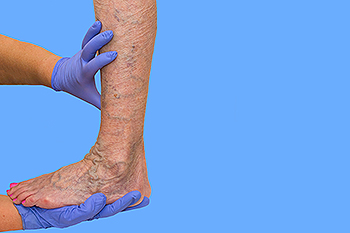
Podiatrists play a pivotal role in assessing vascular disease, a condition that impacts blood circulation throughout the body, including the lower extremities. A thorough examination begins with a detailed medical history, as podiatrists inquire about symptoms such as leg pain, cramping, or numbness. Clinical assessment involves inspecting skin color, temperature, and the presence of wounds or ulcers on the feet, key indicators of compromised blood flow. Podiatrists employ palpation techniques to evaluate pulses in the feet, gauging the strength and regularity of blood flow. The capillary refill test assesses the time it takes for color to return to the toenails after gentle pressure, providing insights into microcirculation. In cases of suspected vascular disease, podiatrists may collaborate with vascular specialists for more advanced diagnostic tests such as Doppler ultrasound or angiography. If you have poor circulation, it is suggested that you schedule an appointment with a podiatrist who can effectively diagnose and treat vascular disease.
Vascular testing plays an important part in diagnosing disease like peripheral artery disease. If you have symptoms of peripheral artery disease, or diabetes, consult with Donald Manger, DPM from Associated Podiatric Physicians, PA. Our doctor will assess your condition and provide you with quality foot and ankle treatment.
What Is Vascular Testing?
Vascular testing checks for how well blood circulation is in the veins and arteries. This is most often done to determine and treat a patient for peripheral artery disease (PAD), stroke, and aneurysms. Podiatrists utilize vascular testing when a patient has symptoms of PAD or if they believe they might. If a patient has diabetes, a podiatrist may determine a vascular test to be prudent to check for poor blood circulation.
How Is it Conducted?
Most forms of vascular testing are non-invasive. Podiatrists will first conduct a visual inspection for any wounds, discoloration, and any abnormal signs prior to a vascular test.
The most common tests include:
- Ankle-Brachial Index (ABI) examination
- Doppler examination
- Pedal pulses
These tests are safe, painless, and easy to do. Once finished, the podiatrist can then provide a diagnosis and the best course for treatment.
If you have any questions, please feel free to contact our office located in Hamilton Township, NJ . We offer the newest diagnostic and treatment technologies for all your foot care needs.
Causes of Stress Fractures
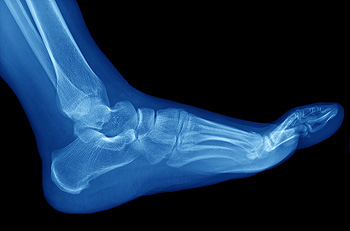
Engaging regularly in high-impact activities, such as basketball, running, or professional dancing, may expose you to the discomfort of a foot stress fracture. This overuse injury involves hairline cracks in the weight-bearing bones of the foot. If left untreated, a stress fracture in the foot can escalate into a more serious concern. However, stress fractures are not always easy to diagnose. Pain upon weight-bearing activities that often subsides after rest is a primary indicator of stress fractures. Tenderness in the affected area, occasional bruising, and swelling around the ankle are other signs to be noted. Various factors contribute to the development of stress fractures in the foot. Overuse and repetitive stress, stemming from prolonged engagement in activities without adequate rest, can subject the foot bones to cumulative stress. Wearing inadequate footwear, whether ill-fitting or worn out, further elevates the risk by providing insufficient support and shock absorption. Suddenly increasing the intensity or duration of physical activity can overwhelm the bones, especially without sufficient time to adapt. Poor biomechanics, such as flat feet or high arches, also can redistribute pressure unevenly across the foot, contributing to stress fractures. If you believe you may have incurred a foot stress fracture, it is suggested that you schedule an appointment with a podiatrist for a thorough exam and suitable imaging tests. Treatment options appropriate to the severity of the injury will follow.
Activities where too much pressure is put on the feet can cause stress fractures. To learn more, contact Donald Manger, DPM from Associated Podiatric Physicians, PA. Our doctor can provide the care you need to keep your pain free and on your feet.
Dealing with Stress Fractures of the Foot and Ankle
Stress fractures occur in the foot and ankle when muscles in these areas weaken from too much or too little use. The feet and ankles then lose support when walking or running from the impact of the ground. Since there is no protection, the bones receive the full impact of each step. Stress on the feet can cause cracks to form in the bones, thus creating stress fractures.
What Are Stress Fractures?
Stress fractures occur frequently in individuals whose daily activities cause great impact on the feet and ankles. Stress factors are most common among:
- Runners
- People affected with Osteoporosis
- Tennis or basketball players
- Gymnasts
- High impact workouts
Symptoms
Pain from the fractures occur in the area of the fractures and can be constant or intermittent. It will often cause sharp or dull pain with swelling and tenderness. Engaging in any kind of activity which involves high impact will aggravate pain.
If you have any questions please feel free to contact our office located in Hamilton Township, NJ . We offer the newest diagnostic and treatment technologies for all your foot and ankle needs.
The Right Shoes for Restaurant Employees

In the bustling world of restaurant service, the right choice of footwear is not a style statement, it is a vital component of safety and comfort for employees who work on their feet for extended periods. Non-slip shoes top the list of essentials, offering stability on potentially slippery kitchen floors. These shoes, designed with slip-resistant soles, reduce the risk of accidents in fast-paced environments where spills are common. Comfort is equally important, considering the long hours spent standing and moving swiftly. Opting for shoes with adequate arch support and cushioning can alleviate foot fatigue and contribute to overall well-being. Additionally, shoes with closed toes provide an extra layer of protection against spills and falling objects. Prioritizing functionality over fashion ensures that restaurant employees can navigate their demanding work environments with confidence, focusing on delivering excellent service rather than wrestling with uncomfortable or unsafe footwear. If you are a restaurant employee and are seeking information about what type of shoes to wear, it is suggested that you speak with a podiatrist.
While working on the feet, it is important to take the proper care of them. For more information about working on your feet, contact Donald Manger, DPM from Associated Podiatric Physicians, PA. Our doctor will treat your foot and ankle needs.
Working on Your Feet
Standing on your feet for long periods of time can cause stress and pain in your feet. Your whole body may experience change in terms of posture, back pain, bunions, callouses and or plantar warts. There are ways to avoid these conditions with proper foot care, smart choices and correct posture.
Positive Changes
Negative heeled shoe – Choosing this shoe type places the heel slightly lower than the ball of the foot. These are great for overall foot health. Find shoes that fit you correctly.
Go barefoot – Our feet were not designed to be enclosed for all hours of the day. Try to periodically expose your feet to air.
Eliminate Pain
Foot Exercises – Performing simple exercises, incorporating yoga and doing stretches are beneficial. This will allow increased blood flow to the area and muscles of the foot.
Achilles tendon – Stretching the foot out flat on the floor will relax the calf muscles and tendon. These exercises can be performed almost anywhere. Make sure you add these exercises to your daily regimen.
With a little bit of this information and knowing more about foot health, you will notice changes. Foot stretches and proper footwear will help with pain and prevent further issues.
If you have any questions please feel free to contact our office located in Hamilton Township, NJ . We offer the newest diagnostic and treatment technologies for all your foot and ankle needs.
Avoiding Limb Amputation From Diabetes

In recent years, the United States has witnessed a concerning rise in lower leg, foot, and toe amputations, with 80% attributed to complications from diabetes. Proactive measures such as lifestyle changes, blood sugar management, as well as regular foot examinations and prompt wound care from a podiatrist can help patients avoid this dire solution. Depending on the severity of complications as the result of peripheral artery disease and neuropathy that are common among diabetics, a podiatrist may offer various interventions. Included are wound cleaning, dead tissue removal, revascularization surgery to restore blood flow, and antibiotic treatments for infection. In extreme cases, however, loss of limb may be unavoidable. Scheduling routine foot screenings with a podiatrist and performing daily foot checks at home to catch potential issues early can help to keep the symptoms at bay. Pain or numbness in feet and toes, fungal infections, changes in color, and swollen feet may indicate serious foot problems. Additionally, ingrown toenails, wounds, and sores are symptoms may need immediate attention. If you suffer from diabetic complications that may lead to limb loss, it is strongly suggested that you are under the care of a podiatrist for regular checkups.
Limb salvage can be an effective way in preventing the need for limb amputation. If you have diabetes, cancer, or any other condition that could lead to foot amputation if left unchecked, consult with Donald Manger, DPM from Associated Podiatric Physicians, PA. Our doctor will assess your condition and provide you with quality foot and ankle treatment.
What Is Limb Salvage?
Limb salvage is the attempt of saving a limb, such as the foot from amputation. Podiatrists also try to make sure that there is enough function in the foot after the salvage that it is still usable. Diabetes is the number one cause of non-traumatic amputations in the United States. Those with diabetes experience poor blood circulation, which prevents proper healing of an ulcer. If the ulcer is left uncheck, it could become infected, which could result in the need for amputation.
However, there are other causes as well, such as cancer and traumatic injury. Links between higher mortality rates and amputation have been found. This translates into higher healthcare costs, and a reduced quality of life and mobility for amputees. Podiatrists have attempted to increase the prevalence of limb salvage in an attempt to solve these issues.
Diagnosis and Treatment
Limb salvage teams have grown in recent years that utilize a number of different treatments to save the infected limb. This includes podiatrists that specialize in wound care, rehabilitation, orthotics, and surgery. Through a combination of these methods, limb salvage has been found to be an effective treatment for infected limbs, and as an alternative to amputation. Podiatrists will first evaluate the potential for limb salvage and determine if the limb can be saved or must be amputated.
If you have any questions, please feel free to contact our office located in Hamilton Township, NJ . We offer the newest diagnostic and treatment technologies for all your foot care needs.


